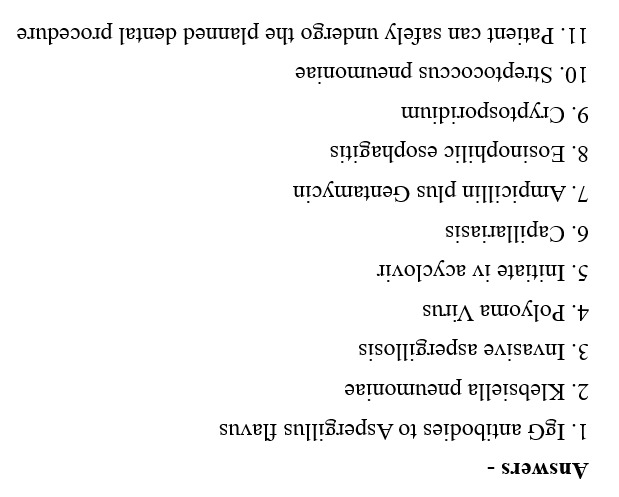https://meditropics.com/pg-quiz/
Kawlashaw Dhawan
PG Resident, Department of Medicine, Lady Hardinge Medical College, New Delhi
- A 19-year-old male student with cystic fibrosis developed acute onset cough which was worsening progressively along with wheezing and increased sputum production. A probable diagnosis of ABPA has been made. Which of the following is incorrect regarding the serological diagnosis for the condition?
a) IgG antibodies to Aspergillus flavus
b) Positive skin prick test
c) Detection of aspergillus specific antibodies
d) Serum IgE levels more than 1000U/mL
2.A 45-year-old female patient with history of diabetes mellitus comes with complaints of fever with chills, yellowish discolouration of skin and abdominal pain for 2 weeks. She also complains of blurring of vision, redness and pain in left eye. Physical examination showed liver tenderness. Blood analysis showed WBC-11000 cell/micro L, Hb-10g/dL, Platelet-3.2 Lakh/micro L and HbA1c-13.2%. LFT showed elevated bilirubin, AST, ALT and ALP. Ophthalmological examination reveals conjunctival and corneal edema, hypopyon and vitreous inflammation in the left eye. CECT abdomen showed liver abscess. Per-cutaneous needle aspiration and culture of aspirate will most likely demonstrate which of the following organism:
a) Staphylococcus aureus
b) E. coli
c) Klebsiella pneumoniae
d) Bacteroides
- A 40-year-old man comes to the office after coughing up a small amount of bright red blood. He has 3 days of fever, pleuritic chest pain and cough productive of thick brown sputum. He started oral antibiotics for these symptoms 2 days ago but has seen no improvement. The patient received allogenic stem cell transplantation for acute myeloid leukaemia 6 weeks ago which was complicated by acute graft vs host disease and prolonged neutropenia. Temperature is 102.2-degree F. BP is 102/66 mmHg, PR-112 bpm. Pulmonary examination shows right sided crackles. Lab results shows haematocrit of 28%, Platelet-1.4 Lakhs/microL, TLC-1500/microL. Chest Xray reveals a dense right upper lobe infiltrate which has grown in size when compared to the Xray from 2 days ago. CECT chest reveals several nodular lesions with surrounding ground glass opacities in the right upper lobe. Sputum gram stain shows inflammatory cells but no organism. Which of the following is the most likely diagnosis?
a) Pneumocystis
b) Pulmonary Tuberculosis
c) Cytomegalovirus
d)Invasive aspergillosis
- A patient who has undergone renal transplantation presents with pain at the site pf transplanted kidney, fever and malaise. The transplantation was performed 8 months back. A renal biopsy was taken and histology suggests nuclear inclusion and interstitial inflammation. Which of the following is most likely the causative organism?
a) Cytomegalovirus
b) Polyoma Virus
c) Pneumocystis
d) Listeria
- A 47-year-old man presented with 2 days of fever, malaise, confusion, hallucination and new onset GTCS. Apart from confusion and poor memory, his neurological examination is otherwise normal. CSF reveals normal glucose, markedly elevated proteins, elevated WBCs with lymphocytic predominant pleocytosis. Axial flair imaging shows asymmetrical swelling and increased signal intensity in the anteromedial temporal lobes more severe on the right. CT of the chest, abdomen and pelvis was normal. Which of the following is the next best course of action?
a) Initiate antipsychotic therapy
b) Initiate iv corticosteroids
c) MRI of spine with and without contrast
d) Initiate iv acyclovir
- Which parasitic organism is a cause of granulomatous hepatitis?
a) Amebiasis
b) Toxoplasmosis
c) Capillariasis
d)Echinococcosis
- A 74-year-old man with a recent history of diverticulitis is admitted to the hospital with 1 week pf fever, malaise and generalised weakness. He has a temperature of 38.5 degrees Celsius., a new mitral heart murmur and splinter haemorrhages. Three blood cultures grow Enterococcus faecalis and an ECHO shows small vegetations on the mitral valve. The organism is reported as sensitive to ampicillin with no high-level resistance to aminoglycosides. Based on this information, which of the following is the recommended treatment?
a) Ampicillin
b) Ampicillin plus Gentamycin
c) Daptomycin
d) Linezolid
- Over the last few months, an adult man has experienced difficulty swallowing with a feeling of food getting stucked below his throat during meals, post prandial vomiting and a burning sensation in the chest. His symptoms did not improve on taking PPI’s. A histopathology sample taken from UGI endoscopy shows eosinophilic infiltrates. What is the likely diagnosis?
a) Eosinophilic esophagitis
b) Crohn’s disease of esophagus
c) Reflux esophagitis
d) Infectious esophagitis
- A 22-year-old male who is a known HIV patient presents with anorexia, nausea and watery diarrhoea, abdominal pain for past 2 week. Histological examination of patient’s jejunum shows basophilic spherical structure attached to the microvillus surface of epithelium. Which of the following is the most likely causative organism?
a) Isospora
b) Cryptosporidium
c) Giardia
d) Entamoeba
- A 24-year-old male patient presents with a history of fever, headache, ataxia, nausea and vomiting. On examination, neck rigidity is present and there is hip and knee flexion on passive flexion of the neck. CSF examination shows the following. Identify the organism.
Opening pressure-200 mm of water
WBC-7000, Neutrophil predominant
CSF glucose conc.-1.2mMol/L
CSF protein-0.7g/L
Latex agglutination positive
Limulus lysate test negative
a) Streptococcus pneumoniae
b) Neisseria meningitidis
c) Hemophilus influenzae Type-B
d) E. coli
11. 54-year-old women is referred to medicine OPD by a dentist. She presented with chief complaints of multiple dental caries and required several fillings. She is a known case of hypertension and mitral valve prolapse. Other than tooth pain, she is apparently well. On examination, there is mid systolic click and late systolic murmur hard over the apex. Which of the following is the most appropriate next line of management?
a) Blood culture
b) Repeat ECHO
c) Provide antibiotic cover with clindamycin and amoxicillin
d) Patient can safely undergo the planned dental procedure
ANSWERS
